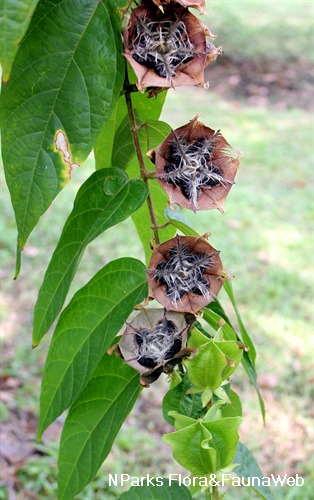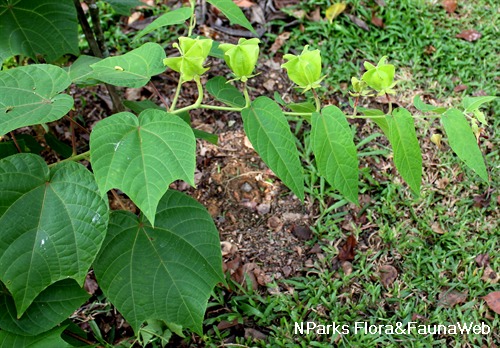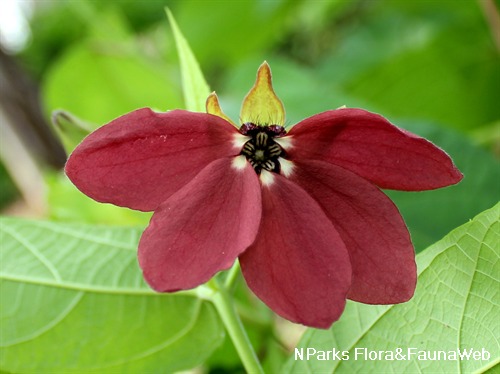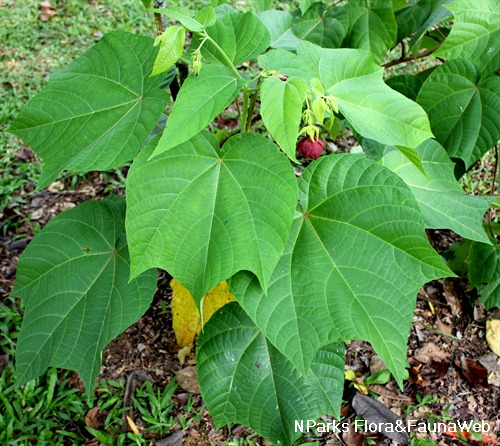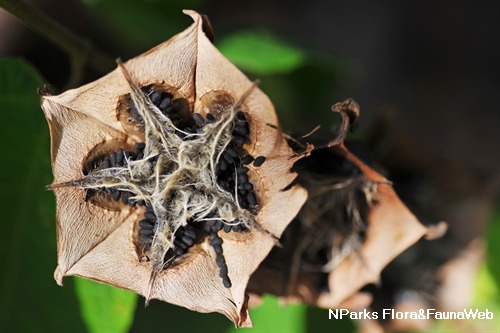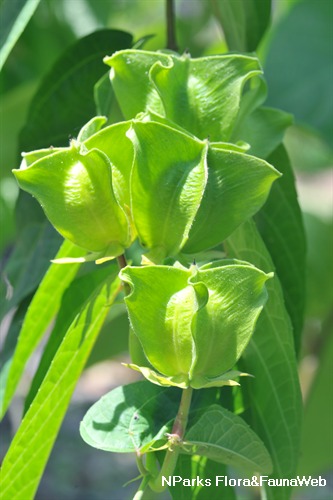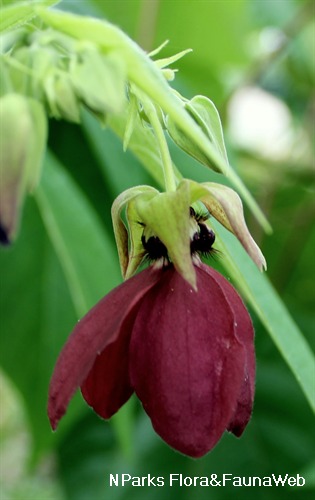
Name
Classifications and Characteristics
| Plant Division | Angiosperms (Flowering Seed Plants) (Dicotyledon) |
|---|---|
| Plant Growth Form | Shrub |
| Mode of Nutrition | Autotrophic |
| Plant Shape | Weeping / Pendulous |
| Maximum Height | 4 m |
Biogeography
| Native Distribution | India to Southeast Asia, northern Australia and the Solomon Islands |
|---|---|
| Native Habitat | Terrestrial |
| Preferred Climate Zone | Tropical |
| Local Conservation Status | Non-native |
Description and Ethnobotany
| Growth Form | It is a shrub, which can grow up to 4m tall. |
|---|---|
| Foliage | The leaves are exist in two forms, lobed and unlobed. The lobed form has longer petiole (10-40cm), 3-5 lobed blade, cordate-ovate shape and irregularly dentate margin while unlobed form has shorter petiole (1-2cm), lance shaped blade and dentate margin. |
| Stems | There are two types of branches, orthotropic branches with lobed leaves and remain vegetative; plagiotropic branches with unlobed leaves where flower usually grows. |
| Flowers | Maroon-coloured flowers, measuring about 3 - 5 cm wide, 5-petaled. |
| Fruit | Fruit is a capsule, papery, 5-winged and angled, contains numerous seeds. |
| Others - Plant Morphology | Most parts of the plant have stellate hairs which are prickly and can cause irritation. |
| Etymology | Genus Abroma is from Greek words "a" and "broma" which means "not" and "food", and it refers to the poisonous nature of the plants. Species augusta means tall and majestic. |
| Ethnobotanical Uses | Medicinal: The decoction of the bark and extracted juice from the fresh root of the plant are used for irregular menstruation treatment, decreases pain in menstruation |
Landscaping Features
| Desirable Plant Features | Ornamental Flowers, Ornamental Foliage |
|---|---|
| Landscape Uses | Parks & Gardens |
| Usage Hazard - Cons | Spines/Thorns - Stem/Branch |
Plant Care and Propagation
| Light Preference | Full Sun |
|---|---|
| Water Preference | Moderate Water |
| Plant Growth Rate | Fast |
| Rootzone Tolerance | Drought Tolerant, Well-Drained Soils |
| Propagation Method | Seed |
Foliar
| Foliage Retention | Evergreen |
|---|---|
| Mature Foliage Colour(s) | Green |
| Mature Foliage Texture(s) | Smooth |
| Foliar Type | Simple / Unifoliate |
| Foliar Arrangement Along Stem | Alternate |
| Foliar Shape(s) | Non-Palm Foliage (Lanceolate) |
| Foliar Venation | Pinnate / Net, Palmate |
Floral (Angiosperm)
| Flower & Plant Sexuality | Bisexual Flowers |
| Flower Colour(s) | Red |
|---|---|
| Flower Texture(s) | Smooth |
| Flower Grouping | Cluster / Inflorescence |
| Flower Location | Axillary, Terminal |
| Inflorescence Type | Cyme |
| Inflorescence Type Remarks | 1-4 flowered cyme at opposite of the leaf or terminal but usually only 1 flower develops. |
Fruit, Seed and Spore
| Mature Fruit Colour(s) | Brown |
|---|---|
| Fruit Type | Dehiscent Dry Fruit |
| Mature Seed Colour(s) | Black |
| Seed Quantity Per Fruit | Numerous (>20) |
Image Repository
Others
| Master ID | 30964 |
|---|---|
| Species ID | 5350 |
| Flora Disclaimer | The information in this website has been compiled from reliable sources, such as reference works on medicinal plants. It is not a substitute for medical advice or treatment and NParks does not purport to provide any medical advice. Readers should always consult his/her physician before using or consuming a plant for medicinal purposes. |

